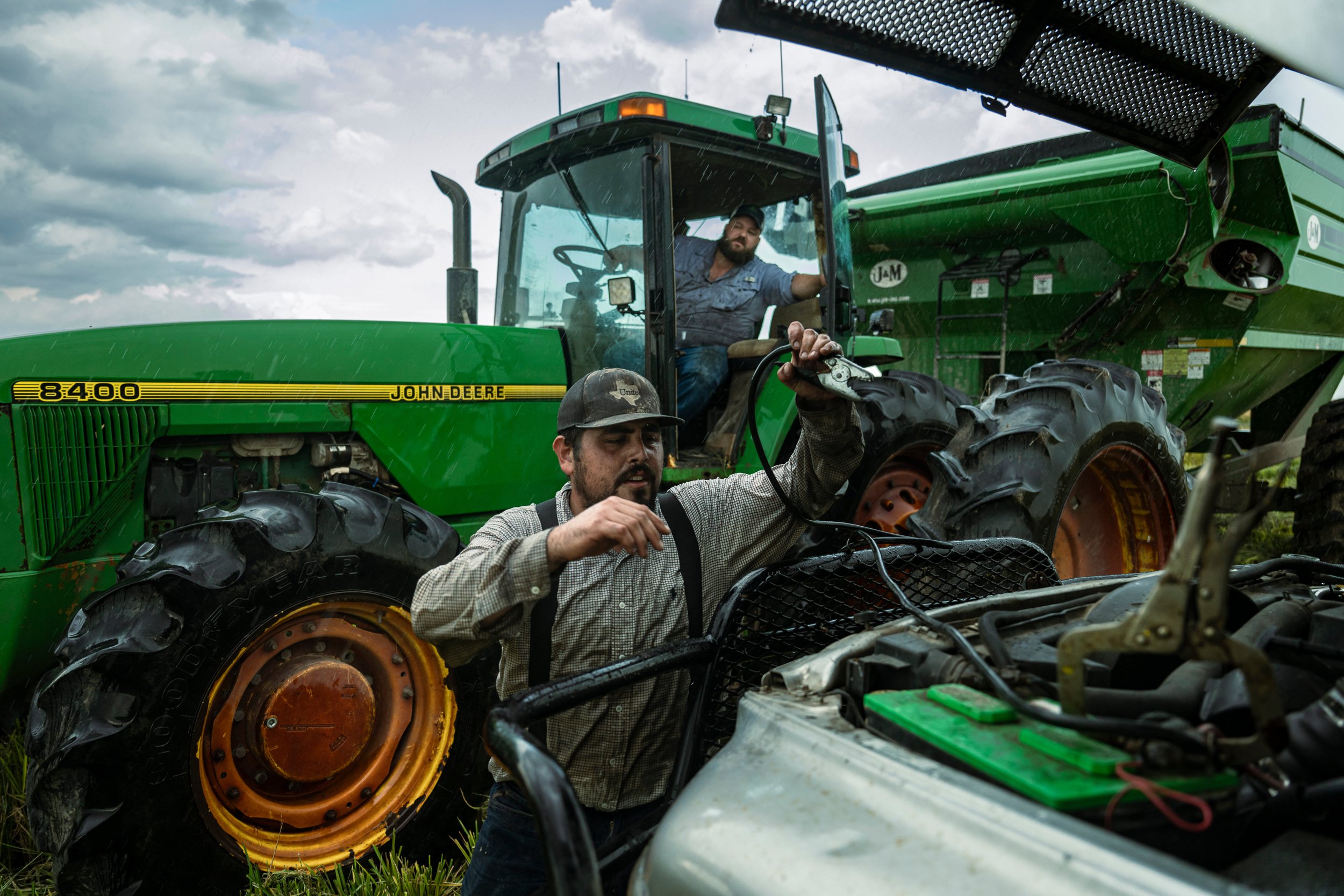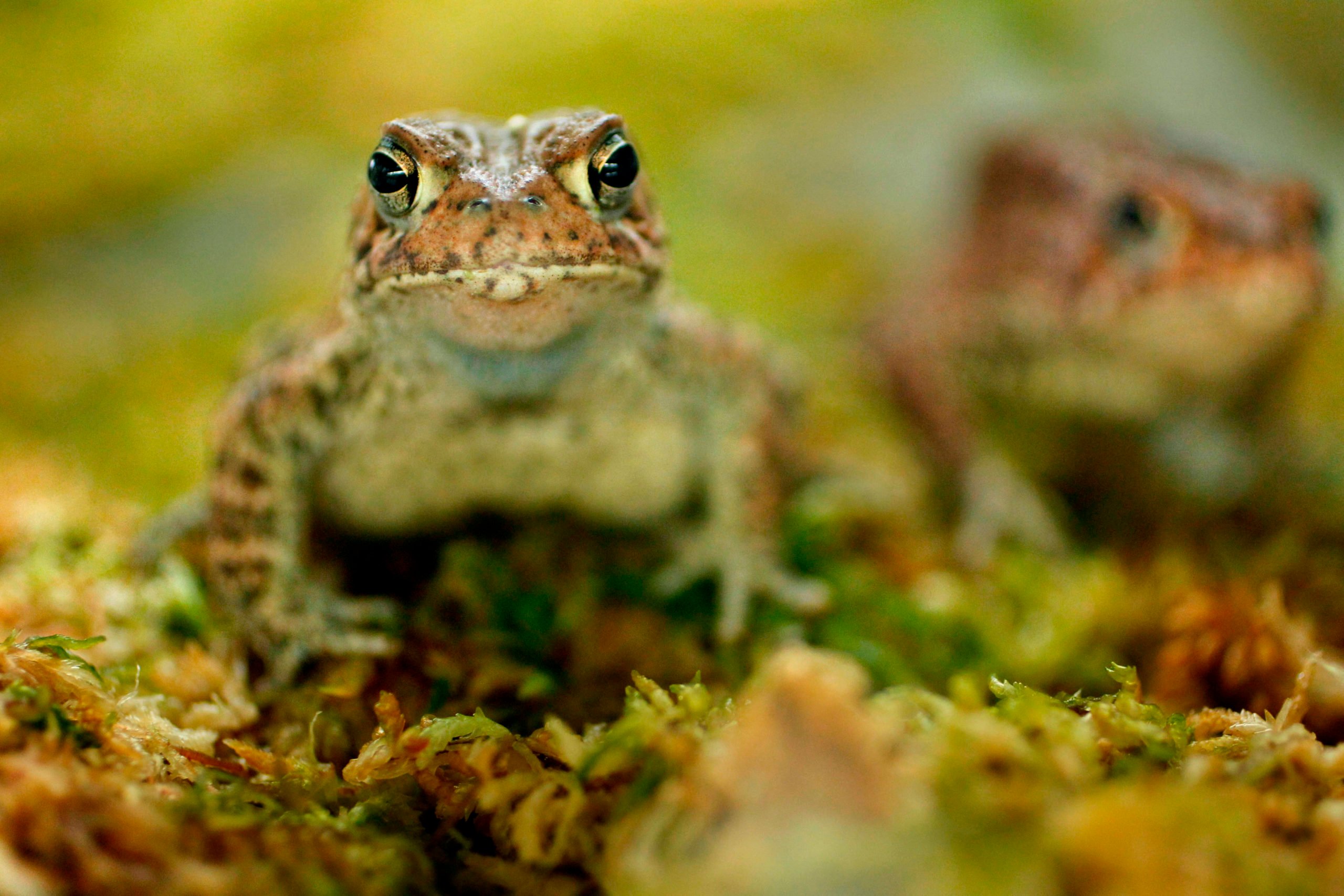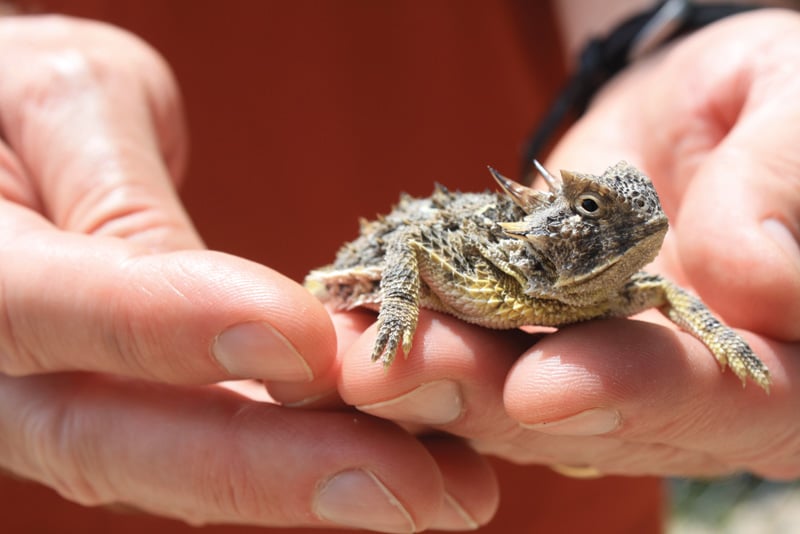
Goodbye to the Horny Toad?
A version of this story ran in the November 2013 issue.
After wresting a semblance of its formerly wild self from the shop-lined canals and flood-control channels of the Alamo City, the San Antonio River winds its way through 60 miles of gently rolling brush country before reaching a “spot of entrancing beauty.”
In the center of Karnes County—known best for its sprawling ranches, uranium mines and, increasingly, hydraulic fracturing operations—Cibolo Creek begins augmenting the San Antonio’s flow. “The clear running waters of these two streams and their tributaries, surrounded by fertile soils, were the grazing grounds of the buffalo, deer, and other wild quadrupeds,” Helmuth H. Schuenemann, homemade historian and former state representative, wrote in 1954.
Schuenemann’s unnamed “wild quadrupeds” probably didn’t include the likes of “Little Stumpy,” a three-legged Texas horned lizard with a scarred-over gash across her face. “I’m sure she met a terrible fate with either a weed whacker or a lawn mower,” said Saundra Schultz, a woman known by many in these parts as “the fish lady,” thanks to the exotic fish business she once operated out of her home.
At almost any other time in history, Stumpy would have been just one of a million: unnoticed, unscarred and almost certainly unnamed. But in the early 2000s, residents here were at the zenith of their lizard awareness. In 2001, the 77th Texas Legislature—inspired by reports of the capture and relocation of nearly 100 official state reptiles from a single town lot—proclaimed Kenedy, just a few miles south of Schuenemann’s bucolic riverine juncture, the Horned Lizard Capital of Texas. Local leaders had already declared their home the Horned Lizard Capital of the World a year earlier and begun promoting the long-overlooked resource. An annual Horny Toad Fun Days celebration seemed an improvement over the flagging flax festival. A Horned Toad Club started educating locals and visitors alike about the threatened Texas horned lizard. Walking tours of lizard hotspots were inaugurated.
(As with so much in the New World, Europeans were perplexed by the lizard. The round and spiny creatures that hunted with a frog-like tongue flick seemed a biological mish-mash. They were not quick like other lizards. Presumed venomous by early settlers due to their monstrous arrangement of spines and the oversized horns on their heads, the easily caught and mild-tempered animals are mistakenly called frogs or toads to this day.)
It was in the context of Kenedy’s enthusiastic embrace that the injured Stumpy had been delivered to Saundra Schultz and nursed back to health to live out her days in her rescuer’s backyard. Two years ago, however, Stumpy disappeared. So had all the frogs and toads behind Schultz’s house. By most accounts the lizards began disappearing from Kenedy between 2006 and 2008. By 2010 they were virtually gone. “I have not seen a horned toad at my house or downtown in two years. I don’t know what happened,” Schultz said. “I hope we didn’t love them to death.”
I’m looking for lizard sign in downtown Kenedy on a 104-degree August day and finding little evidence of those high lizard days. The bars seem to be doing a decent business at midday and the truck traffic servicing the multi-county Eagle Ford shale play is constant. Somewhere nearby is supposed to be a sign trumpeting the town’s reptilian distinction, but the librarian only shakes her head and directs me to the Kenedy entry in a dated copy of the Texas Almanac. Down the hall, however, I stumble upon a push broom leaning against a long dim aquarium outside the city offices. There’s a plastic horned lizard partially submerged in mulch (“laying eggs,” a nearly illegible label reads). Above rests a photo of dozens of children and their oversized chaperones on the Texas Capitol steps. Beside that is a copy of the state proclamation. “The town enjoys the unique distinction of having the largest known population of federally protected Texas horned lizards,” it reads, “and Kenedy residents have embraced the responsibilities of coexistence with this remarkable species.”
The enlightened-sounding portrait belies the typical South Texas town it describes. The land was first seized by the Spanish, Schuenemann contends with the ring of Manifest Destiny, despite “truculent and jealous Comanches” who considered the Cibolo Valley area their “special territory.” Named for a railroad promoter and rancher, Kenedy’s later immigrants tamed the landscape “with pick and grubbing hoe” and rows of thirsty cotton and corn.
Early residents had a habit of gathering at the depot to greet incoming trains, sometimes with gunfire, directed either into the air or at the train itself. This quirk—along with more intentionally homicidal shootouts—earned Kenedy the nickname “Six-Shooter Junction,” an honor shared with a wash of Western railroad towns including Harlingen and Hempstead.
“No section of this county has experienced a ‘boom’ period,” Hedwig Krell Didear wrote in 1969’s Karnes County and Old Helena. But hardscrabble times grew harder still with the oil bust of 1986, the shuttering of nearby uranium mines, federal policies squeezing small-scale farms and, as today, a punishing drought. “We had hit the skids,” Wade Phelps, dentist and president of the Kenedy Horned Toad Club, told me one day at his office, which is decorated with colorful oversized plaster-cast lizards. “The only lifesaver we could hook onto was the Connally prison unit out there. It was the only significant construction of anything in our area through that decade of the ’90s. Everything else was going down.”
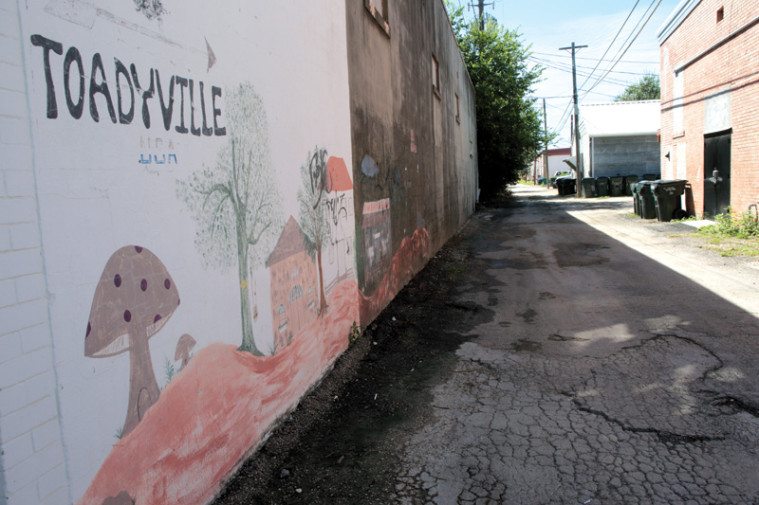
A 1997 relocation effort kicked off Kenedy’s lizard boom. Joe Lang, a former Connally prison guard, city councilman, builder and budding inventor, was working on a property that was to become a noted, though short-lived, bed and breakfast. Knowing the lizards were a protected species—listed as threatened by the Texas Parks & Wildlife Department in 1977, though twice turned down for similar classification by the U.S. Fish and Wildlife Service—Lang sought assistance from the Horned Lizard Conservation Society (HLCS) before spraying the property for termites. His initial altruism wavered, however, when the woman on the other end of the line asked where he lived. “Now just hold on there a second, sweetheart,” he remembered saying. “I ain’t telling you nothing until you guarantee to me that you’re not going to come down here and tell me I can’t renovate this house because of these horny toads, because that ain’t gonna happen.”
The Conservation Society wound up collecting 92 lizards from the property, according to Lang (76, according to the HLCS’s Phrynosomatics newsletter; repeated calls to Texas Parks employee Lee Ann Johnson Linam, HLCS’s Texas contact, were not returned). The lizards were placed in a large bucket for transport to a nearby ranch, where they were released. Lang asked how many lizards the group had expected to find. Five, he was told, would have been considered a successful trip. “And I just made an off-the-cuff remark: ‘So do you think that makes us the horny toad capital?’ And she said, ‘Well, I don’t know why it wouldn’t.’”
With that, Lang and his wife called on Mayor Minnie Robinson to relay the news, ending their tale with a provocative suggestion of possible global prominence. “We’re known as Six-Shooter Junction, but you got people that [say], ‘Oh, well that’s offensive. We don’t wanna do that,’” Lang said. Here was an opportunity to capitalize on something less emotionally charged in an era of school shootings. “By God, let’s make that claim,” he remembers urging Robinson. “And let’s make someone prove to us that they have more horny toads than we do.”
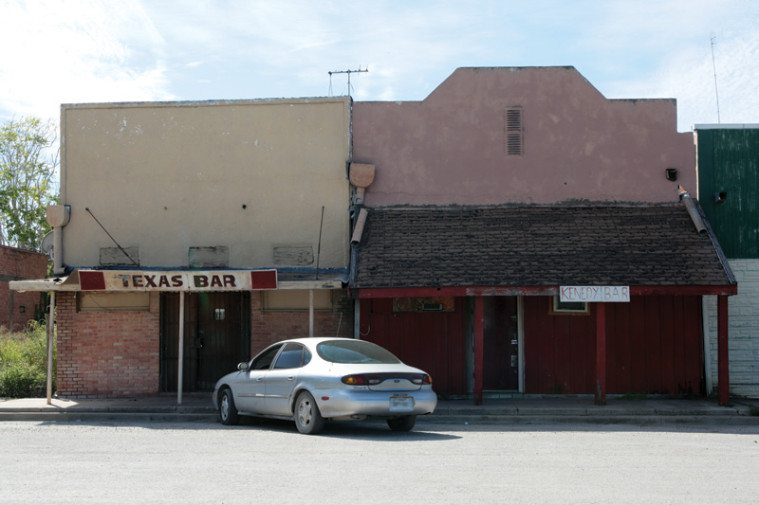
Many indigenous cultures revere the horned lizard—whose various subspecies still range across southern Mexico, the U.S. West, and into Canada—as a symbol of healing and strength. The Tarahumara of Northern Mexico, for instance, are said to believe the lizard possesses a mystical power over creation. (“Don’t tread on me! I am the color of the earth and I hold the world!” anthropologist Carl Lumholtz wrote in Unknown Mexico in 1902.) Throughout Mexico it is broadly known as torito de la Virgin, the “Virgin’s little bull,” likely due to its habit of squirting blood from its eyes.
Though dramatic population declines have made the lizard a rarity in Texas east of I-35 and in large swaths of the state beyond that, the lizards were an unavoidable childhood companion for older generations, objects of both smothering affection and cruelty.
Such was the scope of Schultz’s youthful reptilian interests that her mother would open her dresser drawers with a deconstructed coat hanger. “She’d pull my underclothes drawer open with it because she never was sure what was going to come out,” Schultz said. She recalls catching horned lizards in bulk on her way home from school for lunch. Frequently one would find its way to her bedroom, where she would flip it on its back and rub its belly. She would then place the “hypnotized” lizard tenderly on a fresh pillow and pull clean sheets up under its neck. “I’d put the sheet over their little hands and they would still be in the same spot when I got home from school.”
Wade Phelps speaks of “flying” the lizards from his bicycle’s handlebars as a child. Far uglier stories are out there. As the town’s dedicated horned lizard ambassador, Phelps has heard them all. “Yeah, some of ’em are awful, stories of brutality, mutilation, and people are embarrassed to tell it,” he said. “But it’s almost like people are compelled, they need to get this off their chest.”
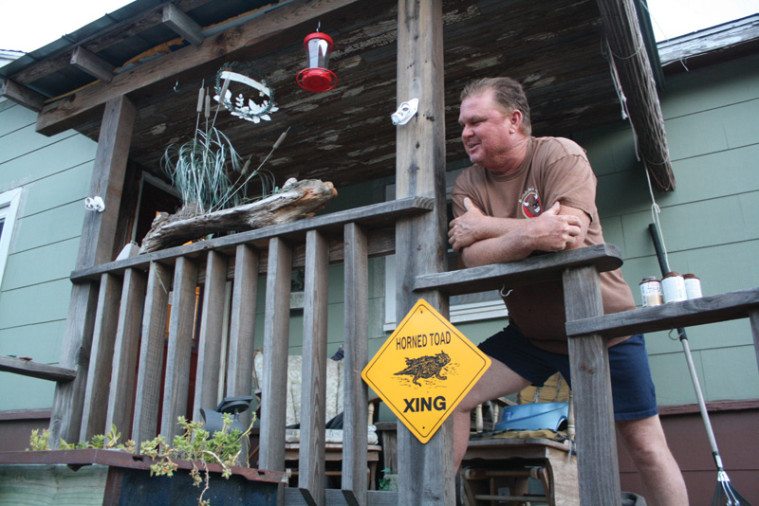
Kenedy’s recently deceased newspaper publisher, Carter Snooks, was a young man when Rip Van Winkle, a horned lizard better known as Ol’ Rip, was pulled out of the Eastland County Courthouse cornerstone after a supposed 30 years of isolation, making statewide and national news.
A county clerk was said to have dropped Rip in the landmark’s wall in 1897 to test popular accounts of lizards living for decades, even centuries, entombed without air, water or food. During the months after his release and subsequent death, Ol’ Rip and later his publicly displayed corpse drew a reliable stream of curiosity seekers.
Even before the 1928 extraction ceremony that led to Rip’s presentation before a crowd of more than 1,500, Eastland Argus-Tribune editor Boyce House had gushed about the effectiveness of his stories, which had been circulated worldwide by the Associated Press news wire, making the Eastland frog “the most famous animal since the serpent in the Garden of Eden.” An estimated 40,000 people lined up to see the animal’s guest appearance at the St. Louis Zoological Society’s reptile house. While some scoffed at the suggestion the lizard had lived so long in solitary confinement, Eastland’s town founder insisted, “It’s just jealousy of Texas that is causing these scientific doubts about that toad.”
House’s stories did more than sell papers. They benefitted Eastland’s merchants, as well, by drawing so many tourists, and the lesson hadn’t been lost on young Snooks, later a newspaperman in Kenedy. Left holding the short straw in this arrangement were the lizards themselves. The sudden market for live lizards from Eastland County’s wilds, or dead mementos made from their remains, constituted a “major horned frog disaster,” according to Texas historian June Rayfield Welch. “Tourists bought thousands of souvenirs and pets. Eastland filling stations gave them away as premium,” Welch wrote in 1993’s O Ye Legendary Texas Horned Frog!
If the Eastland fiasco was a conservation nightmare, it was also a promotional success long remembered by Snooks, who saw an opportunity to recreate it in 1990s Kenedy. “He saw a need for an identity,” Phelps said, “not just another small town withering because of the decline of the family farm. Not just another small town withering because of the oil bust. But to hook an identity to Kenedy: the Horned Toad Capital.”
By plying political connections, Snooks translated the city’s outsized proclamation into a more tempered state version. Phelps says he joined efforts to re-brand the town as a lizard epicenter to soften Snook’s mercenary drive with a conservationist balm. Snooks, Phelps, Lang and Schultz, among others, joined forces in 2002 to produce Horny Toad Fun Days, a children’s event held inside the Ruhman C. Franklin Municipal Building that included lizard-themed stick-horse races and a Horny Toad Game of Life in which harvester ants advanced players two spaces and a feral cat made them lose a turn. “Then you’d go right outside and find horned toads on the property. That’s where I put on my horned toad tours,” Phelps said. “That worked real well for as long as we had the critters.”
The first to be visited by the ghost of Eastland were the Langs. Sightseers and collectors came running after TV’s Texas Country Reporter mentioned the Langs’ B&B, Annie’s Cottage, as a horny toad haven in 2003. “It was nothing for us to see people walking in the alley, ‘Oh, I’m looking for a horny toad,’” Lang said. “Oh, yeah. We had a lot of visitors. Eight o’clock at night, nine o’clock at night, people knocking on the door, ‘I saw y’all on TV the other night, and my grandson hasn’t seen a horny toad and can I show him a horny toad?’ And I’d be like [laughing], ‘Well, they’re sleeping right now’”
Soon after, the lizards had disappeared from behind City Hall.
As a newly installed Texas Parks & Wildlife biologist serving Wilson and Karnes counties in 2010, Ryan Darr went looking for a lizard to show at a classroom presentation. Knowing the town’s reputation as a horned-lizard hub, he was shocked when he couldn’t locate a single specimen. Residents directed him to Phelps and the two hit all the dentist’s favorite spots with no success.
They finally found one lizard, seven miles north of Kenedy in neighboring Karnes City. “I had to ask the question: ‘Well why?’” Darr said. “Was it drought? Was it fire ants? Pesticides? What happened?”
With those questions swirling, Darr was contacted by a biology professor at Texas Christian University, home of the Horned Frogs football team. Dean Williams needed assistance with a statewide Texas Parks & Wildlife-funded horned lizard DNA survey. “It just so happened while he was looking for samples, I was looking for a professor for another research project,” Darr said. The pair joined forces, launching a series of door-to-door surveys and recruiting a graduate student to camp out in Kenedy for the summer of 2013.
The result of all that effort? Ten Kenedy lizards.
Sun-kissed from long days scouring scrub, TCU graduate student Ashley Wall drops surprisingly large scat samples into small plastic collecting tubes. The names of living lizards now outfitted with bulky radio transmitters are listed in her field book. Maggie, the first Kenedy lizard located by the survey, has been joined by Hotdog, Ninja and Princess Leah.
Residents undoubtedly miss the creatures, she says, stepping softly around patches of wheat-blond grass outside an abandoned packing shed in Karnes City. Streams of large red harvester ants, the lizard’s preferred food, pass nearby. Here is scat, but no lizards. She recalls meeting one Karnes County woman who said she and her husband had enjoyed such an intimate relationship with one particular horny toad that she had it buried with her husband when he passed.
Such affection hasn’t stopped the planting of lush imported grasses doused regularly with fire-ant killer—one likely contributor to the decline. Drought has been proposed as a cause. As have climate change, new development eroding old habitat, roaming house cats, and the 24/7 truck traffic. “The Eagle Ford Shale has had a lot to do with it,” former mayor Robinson said. “Several years ago a man told me, ‘In two years you won’t recognize this place,’ and I laughed at him. And he was right. It has totally changed.”
Equally troubling are the many areas once heavily populated with lizards that, aside from their disappearance, haven’t changed at all, Williams said. “For some of these areas, I don’t have an explanation for why they disappeared. Maybe they had very small populations in town to begin with.”
It could be that the sea of lizards around the Langs’ B&B was an anomaly in the first place. It’s likely that the lizards along the Horny Toad Fun Days tour route outside City Hall were limited and vulnerable from the start. Only 10 lizards were found during a 2000 visit to Kenedy by Conservation Society members, according to the group’s newsletter, and no lizards were found at the ranch where close to 100 lizards had been relocated three years earlier.
In the once lively alleyway across from City Hall I spot a weathered mural. “Toadyville U.S.A.” is emblazoned above a painted row of houses, oversized mushrooms and a corral, all under the watchful eye of a bucktoothed ghoul peering out of a two-dimensional second-story window: a witness to decay. Nearly removed by years of South Texas sun are the disfigured yet unmistakable sculpted shapes of horned lizards. Lizards traveling dusty paths, lizards meeting beside a pond, lizards resting in the shade of the mercantile’s porch. They’re missing tails, limbs and, in one case, a head.
At the other end of the building, Schultz is washing up in her art studio. She seems honestly distraught by the vanishing of the lizards. “Nothing different in my yard other than that dang chicken hawk,” she says. Like the drought-inspired coyotes and roadrunners who have started to seek water and prey in town, a raptor has begun visiting each afternoon like clockwork. “Do they eat them?” she asks of the birds. “Because she’s in my neighborhood and the horny toads are not.”
“It’s kind of like, not really dead man walking, but in a sense,” Williams tells me. “There’s some obvious things in some obvious places, but the big picture? I don’t know.”
If only the lizards weren’t so docile, so “gentle and inoffensive” one naturalist wrote in Nature during the height of the curio trade in 1930. It’s a failing, this gentleness, that Phelps has thought long and hard about as he’s processed so many confessions of toad-directed savagery.
“With a small little mammal, that mammal’s going to talk to you. It’s going to tell you, ‘Stop, you’re hurting me,’” he tells me. “You don’t get that from horned toads. So you just keep on going. It’s just the nature of the animal, unfortunately.”
